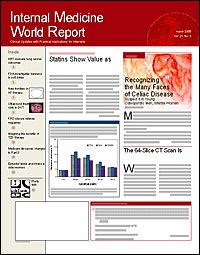Publication
Article
Internal Medicine World Report
Alternative and Conventional Therapies Go Hand in Hand
A new study published in Dia?betes Care (2006;29:15-19) casts substantial doubt on the belief held by many physicians that the use of complementary and alternative medicine (CAM) deters their patients from adhering to traditional treatment regimens.
This analysis looked at data on 2474 adults with diabetes. CAM was considered to include diets, herbs, chiropractic care, yoga, relaxation, acupuncture, ayurveda, biofeedback, chelation, energy healing, Reiki therapy, hypnosis, massage, naturopathy, or homeopathy. Multiple logistic regression analysis was used to determine the effect of CAM on preventive care practices (ie, influenza and pneumonia immunization) and on traditional medical services (ie, number of primary care and emergency department visits).
In 2002, approximately 48% of patients with diabetes reported using alternative therapies. Overall, CAM users were younger, had achieved higher levels of education, were more likely to be employed, and had higher income levels. CAM users were also more likely to receive vaccinations against influenza (48.9% vs 44.8%; P = .040) and pneumonia (50.3% vs 44.6%; P = .007). They were also more frequent visitors to an emergency department (34.6% vs 28.7%; P = .007) and were more likely to see a primary care physician on 2 or more (89.2% vs 84.2%; P = .004), 4 or more (67.9% vs 60.2%; P = .003), 6 or more (35.3% vs 26.9%; P = .002), or 8 or more (16.1% vs 10.8%; P = .009) occasions.
"The major finding from this study was that after controlling for confounding factors, CAM use in adults with diabetes was independently associated with increased likelihood of getting pneumonia vaccination and increased likelihood of visiting an emergency room and having multiple primary care visits," investigators Donald Garrow, MD, of the Medical University of South Carolina, Columbia, and Leonard E. Egede, MD, MS, of the Ralph H. Johnson VA Medical Center, Charleston, Va, wrote.
The investigators cited 2 possible explanations for their findings:
? Socioeconomic advantages
? CAM users may constitute a subgroup of patients who desire autonomy to make their own treatment decisions.
The important conclusion to draw, they noted, is that CAM use does not appear to make patients abandon their use of conventional treatments. Phys?icians who may have otherwise avoided talking with their patients about CAM may want to reconsider and instead "provide balanced discussions about CAM therapies."?R.M.





